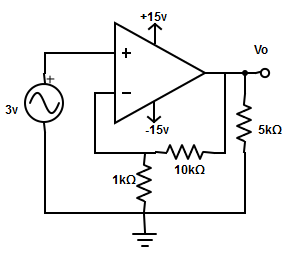61. A feedback amplifier is also called as
A. Open-loop amplifier
B. Closed-loop amplifier
C. Feedback network amplifier
D. Looped network amplifier
62. How many types of configurations are available for feedback amplifiers?
A. Six
B. Four
C. Two
D. Eight
63. Which of the following is not a feedback configuration?
A. Current-series feedback
B. Voltage-shunt feedback
C. Current-Voltage feedback
C. Current-Shunt feedback
64. When load current flows into the feedback circuit, the configuration is said to be?
A. Current-shunt feedback
B. Voltage-shunt feedback
C. Voltage-series feedback
D. All of the mentioned
65. On what criteria does the feedback amplifier are classified?
A. Signal fed back to the input
B. Signal applied to an input
C. Signal fed back to an output
D. None of the mentioned
66. The closed-loop voltage gain is reciprocal of
A. Voltage gain of an op-amp
B. Gain of the feedback circuit
C. Open loop voltage gain
D. None of the mentioned
67. Select the specifications that implies the inverting amplifier?
A. V1 = -3v, V2 = -4v
B. V1 = -2v, V2 = 3v
C. V1 = 5v, V 2 = 15v
D. V1 = 0v, V2 = 5v
68. Specify the voltage gain of a non-inverting amplifier with feedback amplifier with and without feedback?
A. A = Vo/Vid, AF = Vf/Vo
B. A = Vf/Vid, AF = Vo/Vf
C. A = Vo/Vid, AF = Vo/Vin
D. A = Vf/Vid, AF = Vf/Vin
69. If the feedback voltage and the output voltage are given as 10v and 4v. Find the gain of the feedback circuit in the voltage-series feedback amplifier?
A. 2.5v
B. 40v
C. 3v
D. 6.2v
70. How is the difference voltage calculated in a closed-loop non-inverting amplifier?
A. Vid = Vo – Vf
B. Vid = Vin – Vf
C. Vid = Vo – Vin
D. Vid = Vf – Vin
71. Why the feedback circuit is said to be negative for voltage series feedback amplifier?
A. Feedback voltage is 180o out of phase with respect to an input voltage
B. Input voltage is 180o out of phase with respect to a feedback voltage
C. Feedback voltage is in the same phase with respect to an input voltage
D. Input voltage is in the same phase with respect to a feedback voltage
72. Determine the closed-loop voltage gain from the given circuit. (Where gain of op-amp = 105).

A. 1090.9
B. 9821.43
C. 9166.66
D. 10000
73. Express closed-loop voltage gain (AF) in terms of open-loop gain (A. and feedback circuit gain (B)?
A. AF = A/AB
B. AF = 1+ (A/AB)
C. AF = A/(1+AB)
D. AF = AB/(1+A)
74. Which factor determines the gain of the voltage series feedback amplifier?
A. Open loop voltage gain
B. Feedback voltage
C. Ratio of two resistors
D. Gain of the feedback circuit
75. For the feedback circuit of the voltage series feedback amplifier, find the feedback voltage for the specifications: R1 = 1kΩ, RF = 10kΩ, and Vo = 25v.
A. 12.5v
B. 22v
C. 0.9v
D. 2.3v
76. What must be the value of external components used in the voltage series feedback amplifier?
A. Less than 1MΩ
B. Less than 10MΩ
C. Less than 100MΩ
D. Less than 0.1MΩ
77. Define the input resistance with feedback for the voltage series feedback amplifier?
A. RIF = (1-AB.
B. RIF = (AB-1)
C. RIF = (1+AB.
D. None of the mentioned
78. When the non-inverting input terminal of an op-amp is equal to that of the inverting input terminal (ideally)
A. a–>∞
B. Vid ≅ 0
C. AF = 1+( RF / R1)
D. All of the mentioned
79. Find the input and output resistance for the circuit shown.
Specification for 741 op-amp : A = 400000 ; Ri = 33MΩ; Ro = 60Ω;
RF = 11kΩ; R1 = 2kΩ; Supply voltage = ± 15v; Maximum output voltage swing = ± 13v.
A. RIF = 66MΩ, ROF = 30Ω
B. RIF = 30MΩ, ROF = 6kΩ
C. RIF = 15kΩ, ROF = 50MΩ
D. None of the mentioned
80. The output resistance of the op-amp with feedback is
A. Same as that of the output resistance without feedback
B. Greater than that of the output resistance without feedback
C. Smaller than that of the output resistance without feedback
D. None of the mentioned
